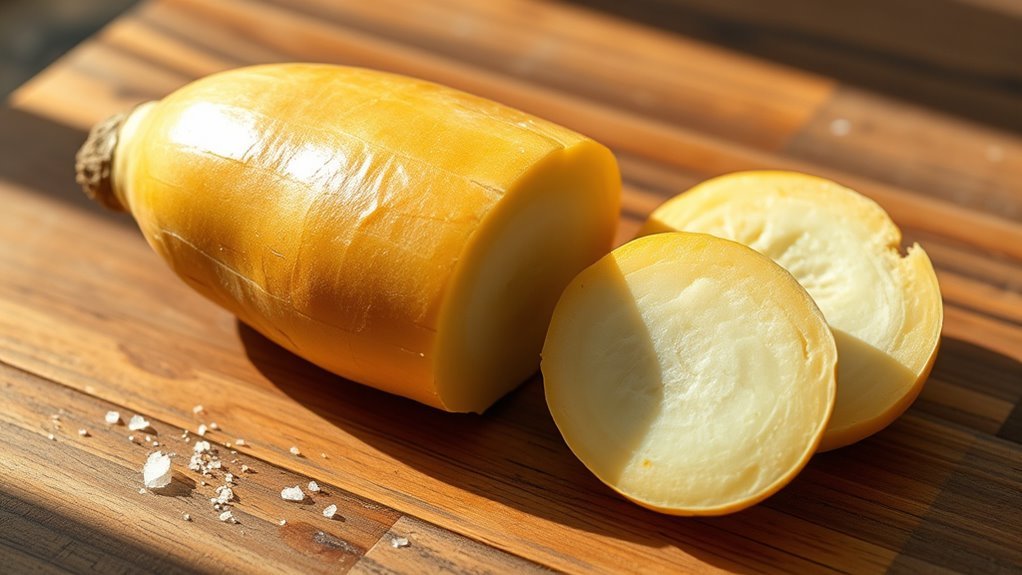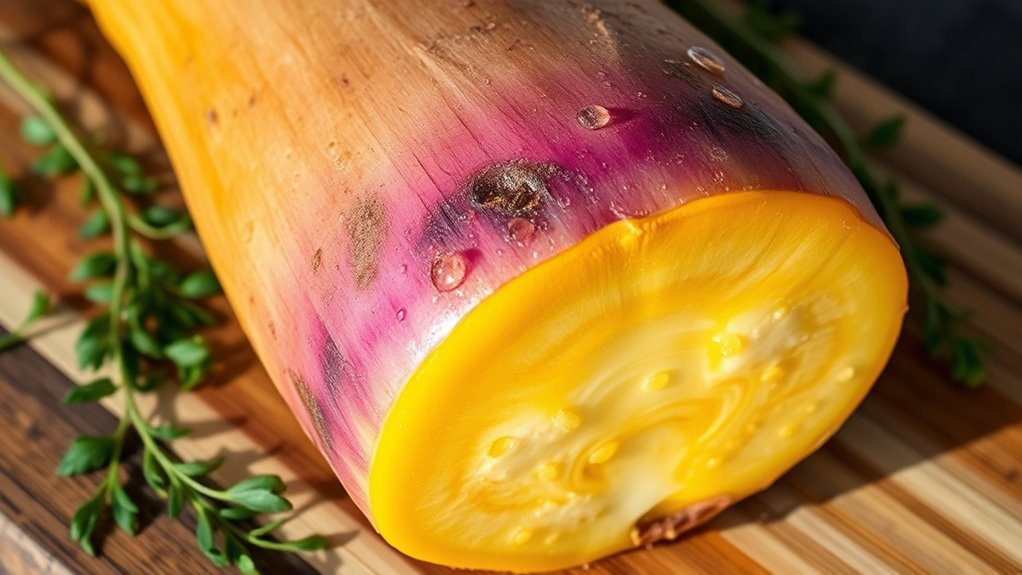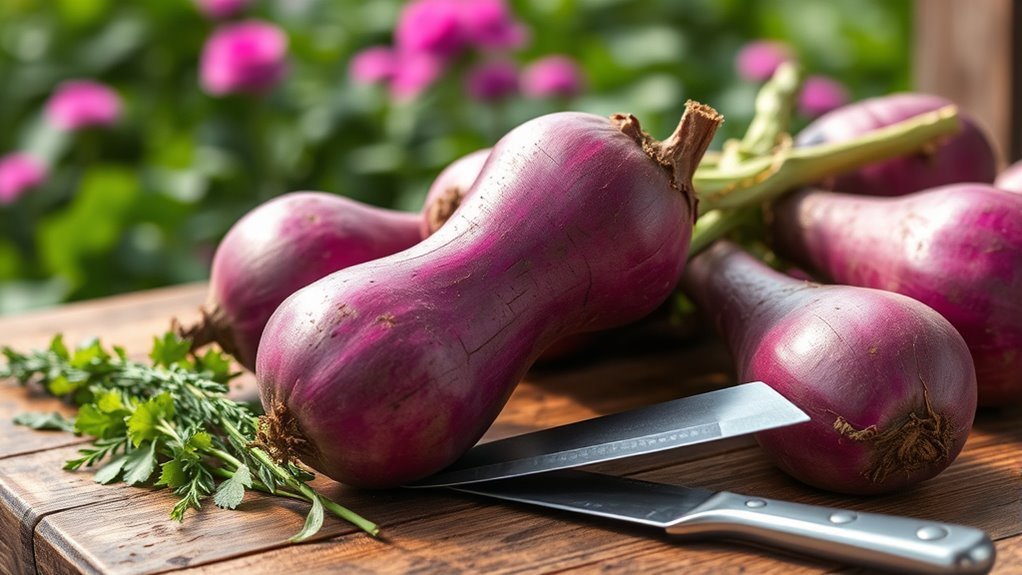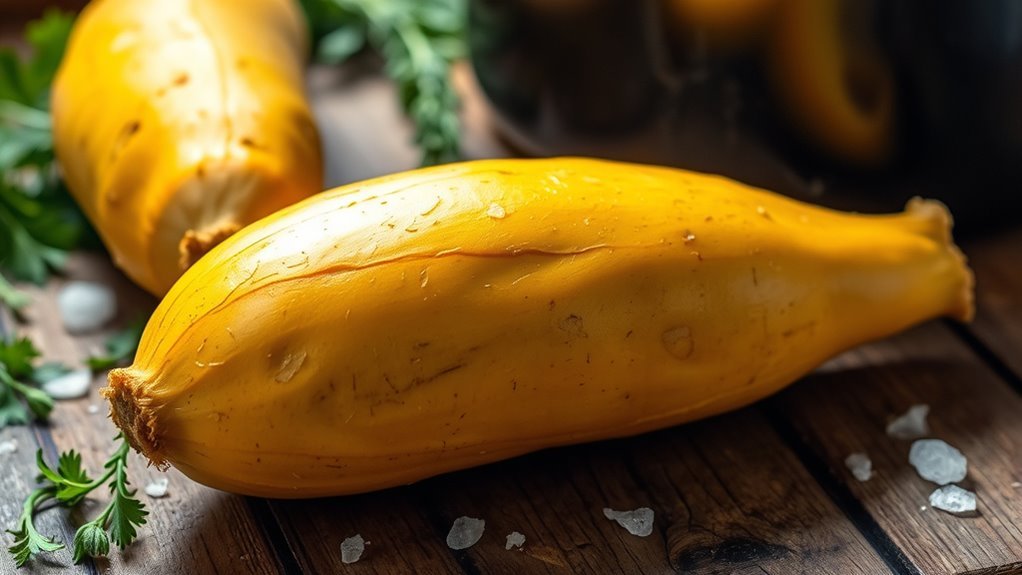Yes, rutabaga is keto-friendly. With about 11 grams of carbohydrates and 3 grams of fiber per serving, it offers a low-carb alternative to starchy vegetables. Its moderate glycemic index guarantees minimal blood sugar spikes, making it suitable for a keto diet. Rich in nutrients, rutabaga can enhance dishes like salads and soups while keeping your carb intake in check. If you’re curious about recipes and other ways to use rutabaga in your meals, there’s even more to explore.
What Is Rutabaga?

Rutabaga, a root vegetable also known as swede or yellow turnip, is a cruciferous plant that’s a cross between a cabbage and a turnip. Originating in Europe, its history dates back to the 17th century, where it became a staple in many diets. You might appreciate rutabaga for its versatility in the kitchen; it’s often roasted, mashed, or even used in soups and stews. Its slightly sweet and earthy flavor can enhance a variety of dishes. In addition, it serves as a hearty substitute for potatoes, making it popular among those following low-carb diets. Understanding its culinary uses can inspire you to incorporate this nutritious vegetable into your meals, embracing the freedom to explore diverse flavors.
Nutritional Profile of Rutabaga

When considering rutabaga’s nutritional profile, it’s essential to look at its macronutrient breakdown and fiber content. This vegetable is relatively low in calories while providing a good amount of dietary fiber, which can aid digestion. Understanding these factors can help you determine how rutabaga fits into your keto diet.
Macronutrient Breakdown
A closer look at the nutritional profile of rutabaga reveals its potential role in a keto diet. It’s important to understand its macronutrient breakdown if you’re considering this root vegetable as a keto alternative. Here’s what you’ll find in a typical serving of rutabaga:
- Calories: About 50
- Carbohydrates: Approximately 11 grams
- Fiber: Around 3 grams
- Protein: Roughly 1 gram
- Fat: Less than 0.5 grams
These rutabaga benefits make it a viable option for those seeking low-carb vegetables. While it does contain carbs, its fiber content can help mitigate the impact on blood sugar levels. As a keto alternative, it can add variety without derailing your dietary goals.
Fiber Content Analysis
The fiber content in rutabaga plays an essential role in its overall nutritional profile, especially for those on a keto diet. As a low-carb vegetable, rutabaga provides a unique combination of fiber sources that can support your digestive health. With about 2 grams of fiber per 100 grams, it helps maintain regularity and can aid in weight management.
Here’s a quick comparison of rutabaga’s fiber content alongside other common vegetables:
| Vegetable | Fiber (g per 100g) |
|---|---|
| Rutabaga | 2 |
| Broccoli | 2.6 |
| Cauliflower | 2.0 |
| Spinach | 2.2 |
| Zucchini | 1.0 |
Incorporating rutabaga can enhance your fiber intake while staying aligned with your keto goals.
Carbohydrate Content in Rutabaga

Rutabaga, often considered a lesser-known root vegetable, offers a unique carbohydrate profile that’s important for those following a keto diet. While it’s not the lowest-carb option, it can still fit into your meal plan if you’re mindful. Here’s what you should know about its carbohydrate content:
- Average of 8-10 grams of carbs per 100 grams
- Contains around 3 grams of fiber, aiding digestion
- Various rutabaga varieties can have slight carb differences
- Versatile in culinary uses, from mashes to soups
- Can be enjoyed in moderation for flavor and nutrition
Glycemic Index of Rutabaga
Understanding the glycemic index (GI) of rutabaga can be essential if you’re managing your carbohydrate intake on a keto diet. Rutabaga, a root vegetable, has a moderate glycemic response, typically ranking lower than many other starchy vegetables. This means it may not cause significant spikes in blood sugar levels, making it a viable option for those looking to maintain stable glucose levels. While it does contain carbohydrates, its lower GI indicates that it can fit into a low-carb lifestyle more comfortably than higher-GI options. Incorporating rutabaga into your meals can provide nutritional benefits without derailing your keto goals. Ultimately, understanding its glycemic index can empower you to make informed dietary choices that align with your health objectives.
Comparing Rutabaga to Other Vegetables
While many vegetables can fit into a keto diet, comparing rutabaga to other options can help you make the best choices for your meal plan. Rutabaga offers unique benefits, but it’s important to weigh these against other vegetables you might consider:
- Carrots: Higher in sugar, can impact your carb count.
- Zucchini: Lower in carbs, great for stir-fry.
- Cauliflower: Versatile, low-carb alternative for rice or mash.
- Broccoli: Nutrient-rich but slightly higher in carbs than rutabaga.
- Spinach: Very low in carbs, perfect for salads.
When making vegetable comparisons, remember that rutabaga benefits include fiber and vitamins, making it a solid choice for your keto journey. Always consider your overall carb intake to stay on track!
Health Benefits of Rutabaga
Rutabaga is packed with essential nutrients, making it a great addition to a balanced diet. Its antioxidant properties help combat oxidative stress, while its low caloric content supports weight management. By incorporating rutabaga into your meals, you can enjoy these health benefits without adding excessive calories.
Nutrient-Dense Composition
If you’re looking for a low-carb vegetable that packs a nutritional punch, rutabaga might just be what you need. This root vegetable offers impressive rutabaga benefits, thanks to its nutrient-dense composition and nutrient diversity. Here’s what makes it stand out:
- Low in calories and carbs
- Rich in dietary fiber, aiding digestion
- Excellent source of vitamin C for immune support
- Contains potassium, promoting heart health
- Packed with antioxidants that support overall wellness
Incorporating rutabaga into your meals can enhance your diet without sacrificing your keto goals. Not only does it provide essential nutrients, but it also offers a satisfying taste and texture that can elevate your culinary creations. Enjoy the freedom to explore new flavors while nourishing your body!
Antioxidant Properties
Because of its rich antioxidant properties, rutabaga can play a significant role in supporting your overall health. These antioxidants, including vitamin C and various phytonutrients, help combat oxidative stress, which is linked to chronic diseases. By incorporating rutabaga into your diet, you can reap antioxidant benefits that may lower inflammation and enhance your immune system. This can lead to positive health implications, such as a reduced risk of heart disease and improved cellular function. It’s essential to recognize that while rutabaga isn’t a magic bullet, its antioxidant-rich profile can contribute to a balanced, health-conscious lifestyle. Embracing foods like rutabaga empowers you to make choices that support your well-being and energy.
Low Caloric Content
When it comes to low-calorie vegetables, rutabaga stands out as a nutritious option that can easily fit into a variety of diets, including keto. Its low caloric content and favorable caloric density make it a fantastic choice for those focused on weight management. Here are some benefits you’ll enjoy:
- Low in calories, helping you maintain a calorie deficit
- Rich in fiber, promoting satiety and digestive health
- Packed with vitamins and minerals, such as vitamin C and potassium
- Versatile in cooking, making meal prep enjoyable
- Supports overall health without compromising your diet
Incorporating rutabaga into your meals not only aids in weight management but also enriches your nutrient intake, allowing you to eat freely while staying on track.
How to Incorporate Rutabaga Into Your Keto Diet
While rutabaga might not be the first vegetable that comes to mind for a keto diet, it can be a versatile and nutritious addition when incorporated thoughtfully. You can start by using rutabaga in salads, adding a crisp, slightly sweet flavor that complements leafy greens and keto-friendly dressings. Try creating a rutabaga stir fry with your favorite low-carb vegetables and protein sources for a satisfying meal. You can also roast rutabaga for a caramelized taste that pairs well with spices and herbs. Remember, moderation is key; while rutabaga offers fiber and vitamins, its carb content can add up. Experimenting with different preparations allows you to enjoy its unique flavor while adhering to your keto lifestyle.
Popular Rutabaga Recipes for Keto Enthusiasts
If you’re looking to spice up your keto meals, rutabaga offers some fantastic options. You can try rutabaga mash as a low-carb alternative, roast them for a crunchy snack, or whip up a comforting rutabaga soup. Each recipe not only highlights rutabaga’s versatility but also keeps your carb count in check.
Rutabaga Mash Alternatives
Although rutabaga is often celebrated for its versatility in the kitchen, there are numerous alternatives to rutabaga mash that can also satisfy your low-carb cravings. These rutabaga alternatives can provide a similar texture and flavor profile while keeping your carb count in check:
- Cauliflower Mash: Creamy and low in carbs, it’s a popular choice.
- Turnip Mash: Slightly sweeter, it’s a great substitute with fewer carbs.
- Zucchini Mash: Light and invigorating, it can be flavored easily.
- Celeriac (Celery Root) Mash: Earthy and rich, it’s perfect for savory dishes.
- Broccoli Stem Mash: Nutritious and unique, it adds a different twist.
These low-carb substitutes can elevate your meals while staying true to your keto lifestyle!
Roasted Rutabaga Snacks
Roasted rutabaga snacks are a delightful and nutritious option for keto enthusiasts looking to satisfy their cravings without sacrificing their dietary goals. You can easily prepare spiced rutabaga chips or garlic rutabaga fries for a satisfying crunch. Both options are low in carbs and high in flavor, making them perfect for snacking.
Here’s a quick comparison of these tasty treats:
| Snack Type | Key Ingredients |
|---|---|
| Spiced Rutabaga Chips | Rutabaga, olive oil, spices |
| Garlic Rutabaga Fries | Rutabaga, garlic, herbs |
These roasted snacks not only keep you on track with your keto lifestyle but also add variety to your meals. Enjoy the freedom of snacking guilt-free with these delicious rutabaga creations!
Rutabaga Soup Variations
When you’re looking to warm up with a comforting bowl of soup, rutabaga can be an excellent low-carb base for a variety of keto-friendly recipes. Here are some delicious variations you can try:
- Creamy Rutabaga Soup: Blend cooked rutabaga with heavy cream for a rich texture.
- Rutabaga and Bacon Chowder: Add crispy bacon for smoky flavor and crunch.
- Spicy Rutabaga Soup: Incorporate chili flakes and cayenne for a kick.
- Herbed Rutabaga Soup: Use fresh herbs like thyme or rosemary for depth.
- Rutabaga and Vegetable Medley: Mix in low-carb vegetables for added nutrition.
Don’t forget creative garnishes like a dollop of sour cream or a sprinkle of cheese! Experiment with seasoning options to suit your taste. Enjoy!
Potential Drawbacks of Consuming Rutabaga
While rutabaga can be a nutritious addition to a keto diet, it’s important to contemplate some potential drawbacks before incorporating it into your meals. One concern is the possibility of rutabaga side effects, which might include digestive issues like gas or bloating, especially if you’re not used to high-fiber foods. Additionally, some people may have potential allergens related to rutabaga, which could trigger reactions in sensitive individuals. If you have a history of allergies to cruciferous vegetables, you should proceed with caution. Finally, rutabaga contains carbohydrates, which could impact your daily intake if you’re strictly monitoring your macros. Balancing these factors can help you decide if rutabaga fits comfortably within your keto lifestyle.
Final Thoughts on Rutabaga and Keto Diets
Although rutabaga can be a nutritious option for those on a keto diet, it’s important to evaluate its benefits against its carbohydrate content and potential side effects. Here are some key points to take into account:
- Low in calories: Great for maintaining a calorie deficit.
- Rich in nutrients: Offers vitamins C and K, fiber, and antioxidants.
- Versatile: Can be incorporated into various keto meals.
- Supports digestion: High fiber content aids in gut health.
- May cause digestive issues: Some may experience gas or bloating.
Incorporating rutabaga into your keto meal plan can provide valuable nutrients, but moderation is key. Ultimately, it’s about finding a balance that works for you while enjoying the benefits of this root vegetable.
Frequently Asked Questions
Can I Eat Rutabaga Raw on a Keto Diet?
You can eat raw rutabaga on a keto diet, and it offers several health benefits. Packed with vitamins and minerals, raw rutabaga can enhance your nutrient intake. Its crunchy texture makes it a great addition to salads or as a snack. If you’re looking for keto diet alternatives, consider pairing it with low-carb dips. Just watch your portions, as it still contains some carbs, but it can fit well into your overall plan.
How Does Rutabaga Affect Ketosis?
Rutabaga can impact ketosis due to its carbohydrate content. While it offers benefits like fiber, vitamins, and antioxidants, it’s essential to monitor your portion sizes. If you’re aiming for strict ketosis, be mindful of how rutabaga fits into your daily carb allowance. Including it in moderation can provide delicious flavors and nutrients without dramatically affecting your ketosis. Ultimately, balance is key, and you can enjoy rutabaga while staying aligned with your dietary goals.
Is Rutabaga Suitable for Meal Prepping?
When you think about meal prepping, you might imagine a fridge full of colorful containers. Rutabaga can be a perfect addition! It’s versatile and can be roasted, mashed, or even used in soups. For meal prep tips, try batch cooking rutabaga recipes like creamy rutabaga mash or spiced fries. Just remember, it holds up well in the fridge, so you can enjoy its unique flavor throughout the week without hassle.
Can Rutabaga Trigger Digestive Issues?
Rutabaga can affect your digestive health due to its fiber content. While fiber’s essential for digestion, too much can lead to gas or bloating, especially if you’re not used to it. If you eat rutabaga in moderation, it’s generally well-tolerated. However, everyone’s digestive system is different, so if you notice discomfort, it might be worth reducing your intake or gradually increasing it to allow your body to adjust.
What Are the Best Storage Methods for Rutabaga?
When it comes to storing rutabaga, using airtight storage containers is key. Keep them in a cool, dark place, ideally at temperatures between 32°F and 40°F (0°C to 4°C). This helps maintain their freshness and prevents spoilage. If you’ve cut or peeled them, refrigerate in a container to minimize moisture loss. With these methods, you can enjoy your rutabaga for an extended period, giving you the freedom to incorporate it into various meals.


